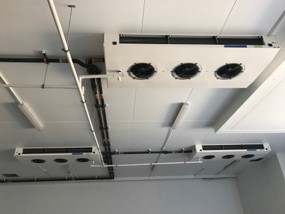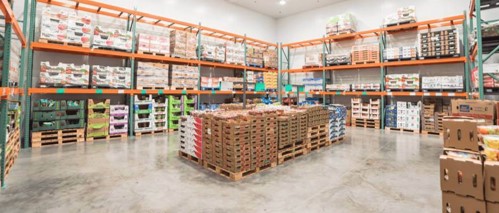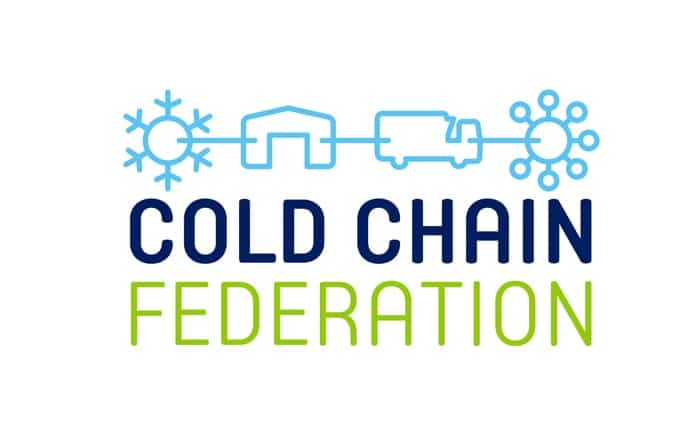At Ryan-Jayberg, we’ve been proudly providing cost-effective commercial storage solutions to a wide range of industries for over 50 years. From butchers to breweries, farmers to florists, there are so many different types of businesses that can benefit from our commercial cold rooms.
Ryan-Jayberg offers an extensive selection of expertly designed and energy-efficient engineering for commercial refrigeration and freezing. When it comes to high-capacity chilling, our variety of refrigeration options includes bespoke commercial cold rooms, tailored to your requirements with our wealth of expertise.
Why choose commercial cold rooms by Ryan-Jayberg?
Whether you’re starting a new venture or upgrading your current premises, commercial cold rooms are an essential investment. Sometimes known as walk-in fridges or cold stores, these built-in refrigeration systems are the best choice for keeping your stock at the optimum temperature.
Installing a custom-fit commercial cold room with Ryan-Jayberg is much more convenient and cost-effective than having several separate upright fridges or freezers. Why would you want the hassle of splitting stock across many areas when you could keep it securely in one place?
Not only do we provide cold rooms for storage at optimal temperatures between 0°C and 18°C, but we also offer commercial freezer rooms for products requiring temperatures from -40°C to 0°C – including blast, carton/box, tunnel, spiral, and deep freezers.
Our made-to-measure commercial cold rooms guarantee the highest standard of materials and durable construction, promising a long lifespan of optimum operation and protection for perishables. Whatever you intend to chill or freeze, Ryan-Jayberg can accommodate your needs.
Environmentally friendly commercial cold rooms
We understand that safety and security are of the utmost importance when storing large volumes of stock, which needs to be both protected and accessible at all times. Our commercial cold rooms always adhere to hygiene and fire safety regulations to keep your business running smoothly, with internal safety releases for peace of mind.
Environmental responsibility is also something we take very seriously at Ryan-Jayberg. We’re committed to helping our valued customers improve the energy efficiency of their systems and reduce their carbon footprint. Not only is this better for the planet, but it also helps your business to keep running costs down.
We’re happy to help you make the smartest design choices for your needs. We can also advise you on the best practices for operation and maintenance, with a dedicated aftercare service available whenever you need us. Our experts can ensure that your commercial cold room continues to run optimally for many years to come.
What can you expect from our cold room installations?
Ryan-Jayberg’s vast industry experience in building temperature-controlled rooms makes us the number one choice for commercial cold rooms. Whichever sector your business operates in, we can accommodate your specific requirements when designing your bespoke commercial cold room.
We’ll guide you through the process from the initial site survey through to the final installation, taking every aspect into consideration. From insulation fabrics, doors, and floors to lighting, ventilation, and drainage, our bespoke service guarantees value for money.
We complete each installation to the specific temperature, size, and shape requirements of the client, ensuring a perfectly fitted and fully integrated refrigeration system every time. Ryan-Jayberg covers all the bases, so you can be sure that your cold room is exactly what you need.
We’re happy to provide a full service, covering the design, manufacture, and onsite build. Our highly trained engineers will be able to advise you on the best materials, layout, and placement for your commercial cold room so you’ll get the most out of your new cold storage facilities.
When we install your custom commercial cold room, the Ryan-Jayberg team will work as quickly as possible on the day – without compromising on quality and safety – to minimise disruption to your business. Your commercial chilled storage room will be up and running before you know it.
Ready to create your bespoke commercial cold room?
Contact us today to discuss our comprehensive commercial cold room service and receive a competitive quote for your ideal cold storage solution.
While we understand that you want to know how much a commercial cold room costs, we cannot provide standard base rates, as the cost depends on many bespoke factors. However, all you have to do is discuss your project requirements with us and we can offer a fair price for the required work.
We always aim to provide the best value for money at Ryan-Jayberg, considering our extensive service and the industry knowledge of our expert engineers that you’ll benefit from. Whatever the scale of your commercial cold room project, we’ll be honest and upfront with you throughout.
Simply give us a call on 0208 944 6288 or fill out our online form and our friendly team of experts will respond as soon as possible. We look forward to helping your business thrive with all the benefits of a highly effective commercial cold room.


Commercial Cold Rooms FAQs
What are commercial cold rooms used for?
Commercial cold rooms are versatile refrigeration solutions used in a variety of settings. They keep perishable products in prime condition and ensure that foodstuffs are safe for human consumption. Cold rooms provide a much larger storage volume than standard fridges, so they’re ideal for keeping stock at controlled temperatures when chest fridges or chilled counters don’t offer enough space.
Unlike regular refrigeration units, cold rooms are usually immobile, requiring installation by specialist fitters like Ryan-Jayberg. Commercial cold rooms also make organisation and distribution easier, as they create a higher capacity of storage shelving, so your stock is always ready when you need it.
Cold rooms are typically used to store chilled ingredients, pre-prepared foods, or ready-made goods. Businesses such as restaurants and supermarkets often use them to keep meat, fish, dairy, or vegetables fresh. However, food retail isn’t the only industry that can benefit from commercial cold rooms.
You can store anything that requires chilling or freezing in them, making them ideal cold storage solutions for a variety of industries such as:
⦿ Butchers ⦿ Breweries ⦿ Farm Markets ⦿ Florists ⦿ Hospitals ⦿ Pharmacies ⦿ Warehouses
From agriculture and horticulture to food processing and pharmaceuticals, bespoke commercial cold rooms can keep everything running efficiently.
What are the benefits of commercial cold rooms for my business?
Commercial cold rooms have many advantages over traditional cooling apparatus. They maximise storage capacity and minimise running costs in the following ways:
⦿ Suitable for a variety of sizes and spaces
Cold rooms can save space when specifically designed to your requirements. Their larger internal storage volume makes them more economical than standard upright fridges/freezers.
⦿ Adjustable temperatures
Airtight cold rooms are protected against exterior climate changes, designed to minimise heat and protect against water ingress. Adjustable gauges allow you to modify the internal temperature as needed.
⦿ Secure and reliable
Lockable storage can prevent theft or damage to high-value contents, with products safely kept at the correct temperature for whenever you need them.
⦿ Better stock distribution
Higher capacity cold rooms make arranging stock very simple, so stored items are then much easier to find. This makes trips into and out of the cold room much faster, speeding up your stock rotation.
⦿ Accessible and convenient
Cold rooms are more straightforward to construct onsite than carrying refrigerator units through doorways. They're also much more convenient for staff to access when accepting stock deliveries, or replacing stock in the main storage area.
Which other types of commercial cold storage are available?
The three main types of storage are refrigerated (or chilled), frozen, and dry. While chilled and frozen items require a controlled climate to maintain their shelf life, dry items can simply be stored in any kind of cupboard or pantry. For smaller businesses, it’s often easier to use freestanding chilled or frozen storage, such as:
⦿ Refrigerated bottle coolers, display cabinets, and promotional displays
⦿ Serve-over cabinets for keeping goods chilled, frozen, or heated
When a larger solution is needed, it’s possible to obtain a specialist refrigeration unit from a bespoke provider like Ryan-Jayberg. We also offer refrigerated cabinet refurbishments, for when existing chilled or frozen storage units need repairs.
Of course, if these options aren’t to the scale that you need, a commercial cold room is the best temperature-controlled storage solution. We provide many types of cold rooms at Ryan-Jayberg, from commercial to public to private services. They can be built into existing areas within your premises and fitted with shelves or pallet storage.
Whether you need multi-temperature storage or a straightforward cold storage room at chilled or frozen temperatures, we're sure to offer a suitable service at Ryan-Jayberg. Not only can we assist with all manner of retail cold rooms and distribution centre cold rooms, but we can also tailor our services for scientific research cold rooms and pharmaceutical cold rooms.
How do commercial cold rooms work?
A commercial cold room is a larger scale walk-in fridge or freezer, constructed with insulated panels to form a sealed temperature-controlled space. Cold rooms keep all products stored in them at a set temperature by extracting warm air from outside the room, filtering it through cooling units with refrigerant chemicals, then blowing the cooled air into the cold room itself.
A thermostat controls the optimal temperature inside the room and constantly monitors for any changes, adjusting the temperature accordingly if it gets too high or too low. There’s usually a variation of 2-4°C allowed before the thermostat will signal to the cooling unit that the room’s ambient temperature is out of the acceptable range.
These are the standard components of a cooling system and what they do in the cycle:
⦿ Compressor – pressurises the refrigerant gas.
⦿ Condenser – cools the hot gas to turn into cold liquid.
⦿ Expansion Valve – controls the flow of liquid and turns it into vapour.
⦿ Evaporator Coils – boils liquid gas to expand it and cool the coils through energy absorption.
⦿ Fans – circulates air over the cold coils to distribute cool air around the room.
Additionally, the insulation panels lining the room also help to maintain the temperature. Layers of non-conductive material in the walls, floors, and doors keep cold air inside and prevent warm air from outside from getting in. Without insulation, the cooling unit would inevitably burn out much faster, as it would have to work harder to keep the room cool.
Got any more questions about how our commercial cold rooms work? Contact Ryan-Jayberg today and we’ll gladly assist with your enquiries.
What’s the best temperature for a commercial cold room?
Refrigeration or freezing is necessary for many items, from food to medicine, to preserve their fresh state and delay deterioration until you need to use them. Perishables such as raw meat, dairy, and fresh fruits and vegetables commonly require chilling or freezing as quickly as possible.
Commercial cold rooms tend to operate between -40°C to 18°C, but the required temperature will depend on the particular items you’re storing. Generally, the ‘danger zone’ for bacteria growth is around 5°C to 60°C, so any chilled products should be stored at no more than 4°C.
While we recommend 2-4°C for refrigerated produce, the temperature should be at least -15°C for frozen products. We recommend -18°C to -20°C for keeping frozen goods in prime condition. Any lower and you risk causing freezer burn, and slowing operations down with a long defrosting time.
With the bespoke service from Ryan-Jayberg, commercial cold rooms and freezer rooms are designed to individual temperature requirements, ensuring that your business needs are completely catered for. You can contact our team with any enquiries you might have about our services.
How do you design and install commercial cold rooms?
The first step beyond the initial concept is to understand the temperature requirements of your commercial cold room, allowing us to configure the cooling system according to your business needs. Next, a survey of the premises can identify the best possible location for the cold room and provide accurate measurements.
Using this information, we can work with you to come up with a suitable commercial cold room plan. We consider the best use of space and insulation for efficiency, implementing your input on materials, ventilation, and layout to design a bespoke cold room in line with your specifications and budget.
Once you sign off on the final design, we’ll get to work procuring the components. Then, on your specified installation date, our trained engineers will construct your cold room on-site. When the fitting is complete, we’ll test the system to identify any operational issues. Don't worry - we won't leave without running through the instructions on how to use and maintain the cold room.
We aim to make this process as smooth and swift as possible to reduce your downtime, so you can quickly get back to work with your new commercial cold room. Of course, if any problems do occur down the line, you can always get in touch with Ryan-Jayberg for engineering assistance.
How do you maintain commercial cold rooms?
Keeping up with commercial cold room maintenance can initially seem like a lot of effort, but creating a routine for regular maintenance checks will soon make it feel like second nature. Consistent care, including cleaning, is vital to keep your cold room working to its full potential.
If you allow your commercial cold room to fall into disrepair, it can have drastic consequences for your business. Thawed products can quickly become unfit for consumption, and on top of the costs of repairs and replacements, this will waste a lot of money.
These problems are largely avoidable, as long as you regularly check over your cold room. The sooner you identify faults, the easier they’ll be to deal with. Here are some of the things you can look out for when checking your commercial cold room:
⦿ Temperature – Is it within the required range? Do you need to reset the thermostat?
⦿ Evaporators – Has any ice built up that can impede their operation?
⦿ Compressors – Can you see any leaks or other signs of damage?
⦿ Freon – Are freon levels at the optimum amount?
⦿ Vents – Is there any dust or debris that can lead to overheating?
Air vents at floor level especially can collect dirt and debris, and any blockage can cause the system to overheat, shortening its lifespan before it wears out. You should clean the whole area daily to avoid bacteria building up or trip hazards.
Of course, you should also pay attention to the produce itself. Discolouration, softened texture, and unpleasant smells are all indicators that the products have deteriorated, signalling that there must be something wrong with the cooling system.
Luckily, the qualified professionals at Ryan-Jayberg are available for maintenance contracts, allowing you to have an expert on hand if any issues do arise. Feel free to contact Ryan-Jayberg at any time with concerns about commercial cold room maintenance.
Can mould grow in a commercial cold room?
If a commercial cold room isn’t properly constructed by a professional, it’s likely that there will be issues with the insulation, sealing, and temperature control. When hot air keeps getting into the chilled space, this can lead to a build-up of condensation on surfaces. Excess moisture can quickly become a breeding ground for bacteria and fungi if left unchecked - so don't let things get that far.
This is why it’s so important to maintain the mechanics of your cold room and clean it regularly. There’s no need to use heavy-duty cleaning chemicals, which can actually damage the surfaces and seals, but frequently wiping everything down and keeping an eye out for signs of damp or leaks should help to prevent mould.
While you’re likely to need a mop and damp cloths to clean the cold room, always be sure to dry the surfaces after cleaning them. Not only is leaving water or liquid build-up on surfaces a slipping hazard, but it also creates opportunities for unwanted mould to grow. You should also mop up any spillages inside the room quickly.
Make sure that items inside your cold room are stored properly, especially organic perishables like meat. Never use wood or cardboard for storage – even if it’s treated and sealed, it increases the risk of mould. Contaminants like mould spores can originate from outside the room, too, so be sure to keep the cold room door closed.







